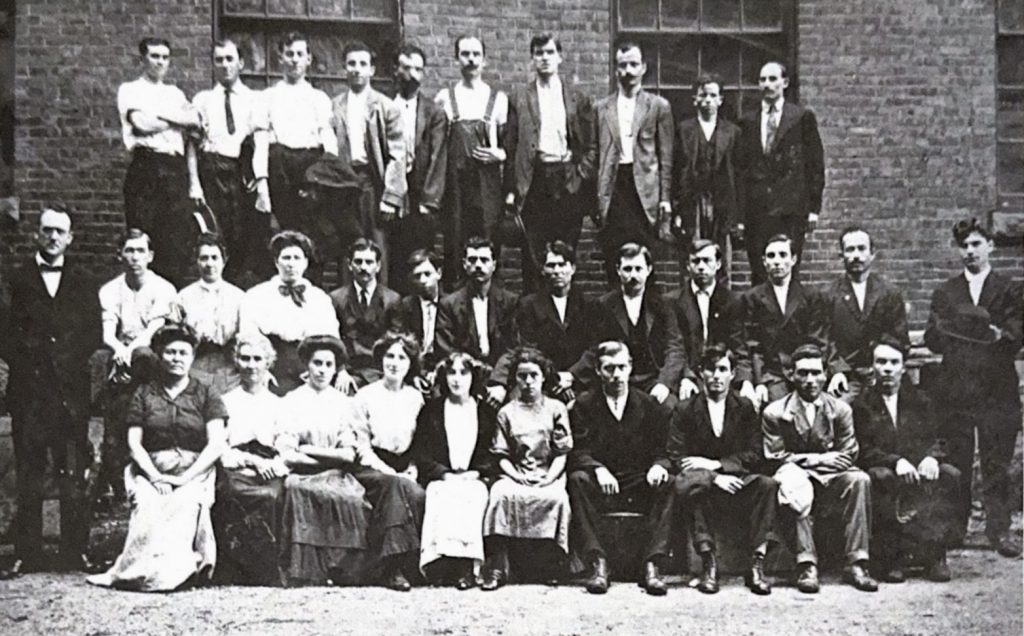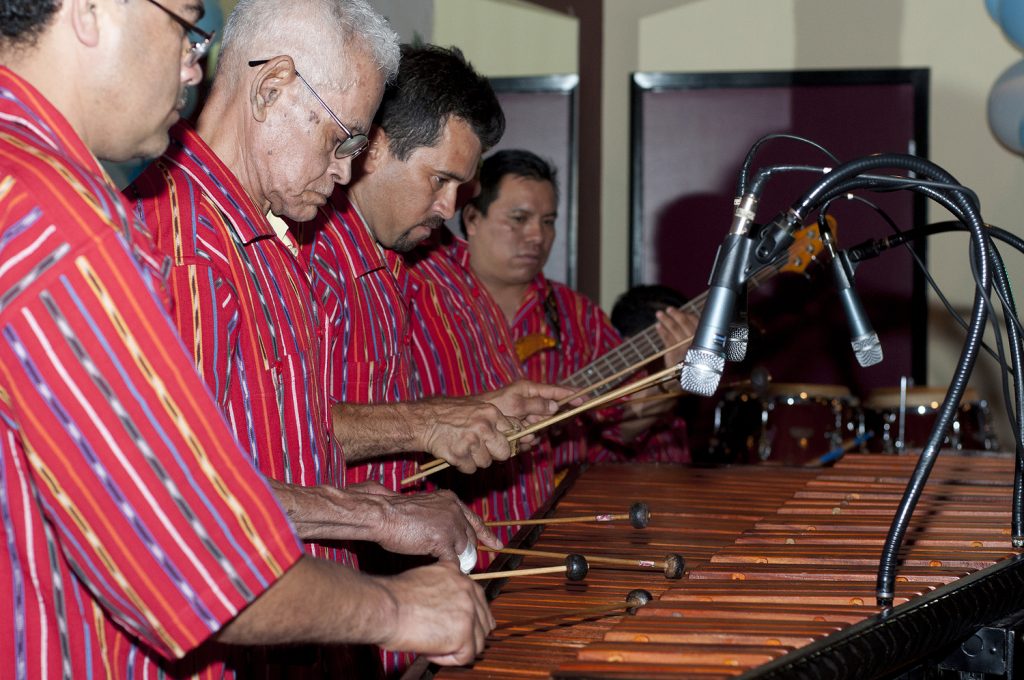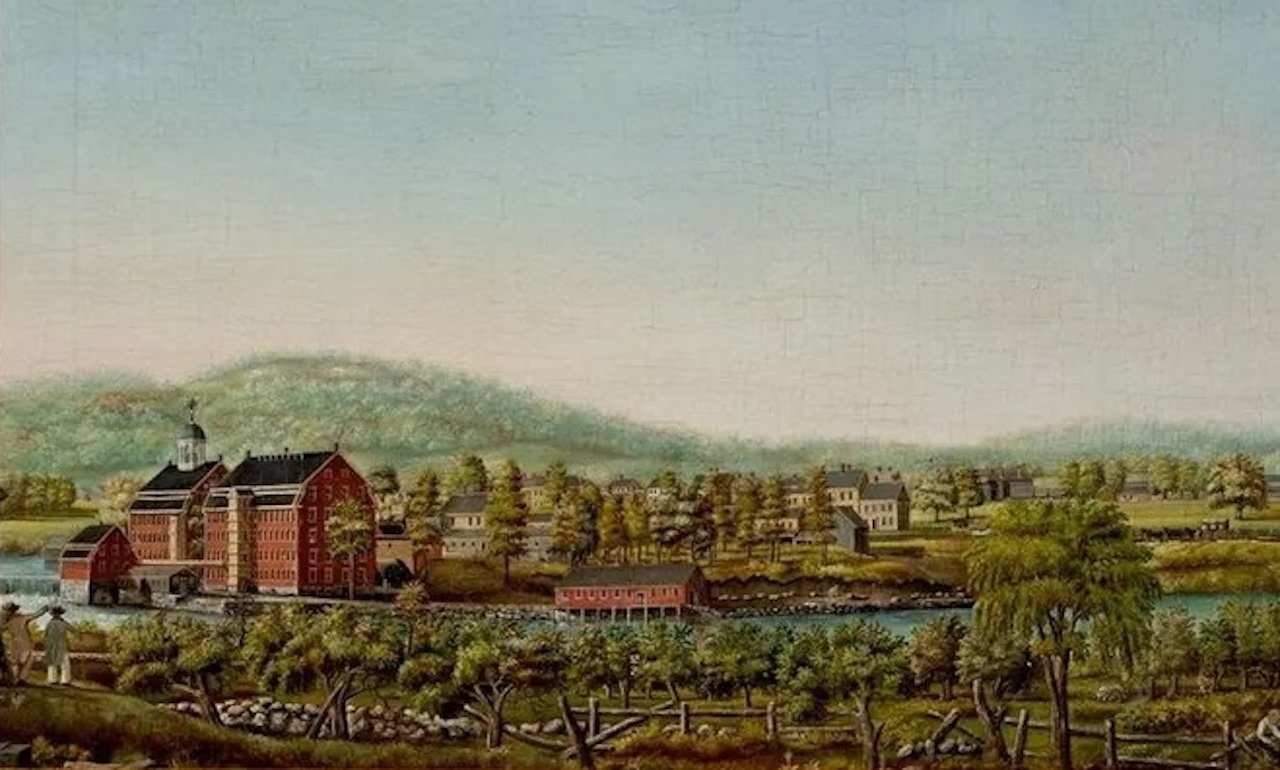View of the Boston Manufacturing Company ca. 1816, the first fully-integrated factory in the US that attracted thousands of immigrants to Waltham in the late 19th and early 20th centuries. Image photographed by David Bohl, courtesy Gore Place and the Charles River Museum of Industry and Innovation.
A walk down Waltham’s Moody Street reveals a striking array of immigrant-owned and operated markets, restaurants, and shops. Today, Indian-owned Waltham India Market is reminiscent of earlier immigrant owned stores, such as the once popular Italian grocery, Ristuccia’s Moody Street Market. Through the generations, immigrants have cultivated the core of Waltham’s commerce and culture. Moody Street’s place at the heart of the city dates back to Waltham’s earliest immigrants and the commerce they established there, starting in the 1850s.

Waltham’s prominence as a center of immigration is rooted in its long industrial history stretching back to the early 19th century. In 1814, the Boston Manufacturing Company (BMC) opened in Waltham. The first fully-integrated factory in the country, the BMC incorporated all processes to turn cotton into cloth. The Waltham Bleachery and Dye Works soon followed as a subsidiary of the BMC. In 1854 the Waltham Watch Factory joined the Boston Manufacturing Company as one of Waltham’s key employers; it was the first factory to produce a finished watch and all its components under one roof.
Attracted by the wealth of jobs available in Waltham’s booming industries, Irish immigrants flocked there beginning in the 1850s. They settled within walking distance of the factories on Charles, Felton, and School streets. St. Mary’s Church on School Street, built in the late 1850s, flourished as a spiritual and community center for Irish Catholics. French Canadians followed the Irish beginning in the 1880s. Working primarily at the Waltham Watch Factory, they too settled along Charles and Felton streets. To preserve their Catholic traditions and hold mass in their native tongue, the French Canadian settlers founded St. Joseph’s Parish, Waltham’s second Catholic church.
The early 20th century saw a new wave of immigrants consisting of Italians, Jews, and Swedes. The Italians soon became one of Waltham’s most populous immigrant groups, second only to the Irish. Like many new settlers, they found work in Waltham’s industrial sector at the Boston Manufacturing Company, the Waltham Watch Factory, as well as newer corporations in the surrounding area. Outside of factory work, some migrants used their farming skills from the Italian countryside to become fruit dealers, starting farms nearby and supplying produce to the Boston area.

Since the late 1980s, Waltham has experienced a new wave of immigrants and refugees largely from Guatemala, China, India, Haiti, and Uganda. The city’s Guatemalan community makes up the largest group of foreign-born settlers, including both Spanish and Mayan speakers. Originally attracted to Waltham for its job opportunities, today many migrants find themselves drawn to the city’s Guatemalan culture and community. Settling initially around Calvary street, many have found occupations in landscaping, construction, and domestic work. Founded in Waltham in 2009, the non-profit organization Casa Guatemala serves Guatemalans across Massachusetts. It aims to preserve Guatemalan culture, assist those in need, and advance the education of young Guatemalans.
As of 2016, Waltham followed only Boston and Cambridge in most requests for H-1B visas, a type of visa to bring highly skilled workers into the United States. Since the 1990s, computer firms have recruited Indian immigrants specializing in programming and engineering, who have subsequently settled in Waltham. Similarly, many Chinese immigrants who have settled in Waltham work in STEM, particularly in computer and mathematical occupations.
Like other earlier immigrants, Haitians have settled along Calvary and Felton streets. As a result of Waltham’s proximity to Boston, many Haitians have found occupations in hospitals, hotels, restaurants, construction, and janitorial work. An increase in Haitian settlement allowed the community to purchase and convert St. Joseph’s Roman Catholic Church into the New Covenant (Protestant) Church. Haitians in and around Waltham flock to the church for community, camaraderie, and culture. Ugandans, though a small group, have been settling in Waltham since the 1970s, but their numbers have grown significantly in the 21st century. St. Mary’s Parish, once the home for Irish immigrants, now functions as the headquarters of the Ugandan Catholic Community of Boston, while St. Peter’s Anglican Church also hosts a Ugandan congregation.
Though the faces of Waltham have changed over the years, the city has remained an attractive location for migrants since the mid-19th century thanks to its prosperous economy, more affordable housing, and proximity to Boston. For more than 170 years, immigrants from across the globe have made and continue to make Waltham their home.
–Brieanna Allen, Boston College ’25
Sources and Further Reading
Burge, Kathleen. “Little Kampala: With Students Pioneering the Way, 1500 Ugandans Now Live in Waltham,” Boston Globe, August 20, 2009.
Casa Guatemala website.
Peterson, Kristen A., and Thomas J. Murphy. Waltham Rediscovered: An Ethnic History of Waltham, Massachusetts. Waltham, MA: Peter E. Randall, 1988.
Rivera, Lorna. “Latinos in Greater Boston: Migration, New Communities and the Challenge of
Displacement.” Mauricio Gastón Institute for Latino Community Development & Public Policy, University of Massachusetts, Boston, 2019.
Saint Mary Parish, “Parish History.”

